The recent pandemic affected all aspects of life. But two experienced the biggest shifts—the way people shop and the way businesses sell to their customers.
Nearly 70% of consumers report they shop differently since COVID-19. And by differently, they mainly mean online.
While many industries were hard hit, the eCommerce sector witnessed rapid growth. After all, customers were locked in their homes, having no other choice but to opt for online shopping. So even those businesses that didn’t embrace the realm of digital were forced to quickly adapt eCommerce practices and move their sales online.
This simply means that even more companies now enter the digital race and enter the world of eCommerce.
For many, though, it’s a brave new world with a lot of unknowns. This comprehensive guide will walk you through the ins and outs of eCommerce search engine optimization (SEO) best practices and all the key ways to optimize your site for ultimate success.
Importance of SEO for eCommerce Websites in 2022
Major e-tailers—from Amazon to Walmart—typically have an all-around digital eCommerce strategy. They have the manpower, budgets, and resources to invest in advertising, social media, influencer marketing, SEO, and all channels common and uncommon.
Not all businesses, though, can afford to be present across each and every channel. And you don’t have to either.
But SEO is an absolute must-do if you’re serious about competing against all the other players.
Semrush’s study shows that SEO is the third most impactful traffic source for eCommerce companies, bringing 20% of their digital footfall. Number one is Direct but you have to work hard to achieve such brand recognition.
 Source: Semrush Blog
Source: Semrush BlogBut apart from traffic—the main goal of all your marketing efforts—there are other reasons to turn to SEO as well:
- SEO comes with some of the highest returns on investment among all types of marketing campaigns.
- Online advertising costs tend to rise with every year, so organic practices bring much more value per dollar spent, even if you count the hours spent optimizing your site.
- SEO does require a lot of initial effort, but the results tend to be more sustainable and long-term, which pays off over time.
After all, as Forrester reports, 71% of the customers begin their buying journey with a search, and even more—74%—use the search engines to complete it. After the pandemic, these numbers are probably even higher.
6 BEST eCommerce SEO Optimization Strategies That Actually Work
Now that you hopefully understand why no e-tailer can thrive without having the top ranks on Google’s SERPs (search result pages), you are probably wondering how do you really get there?
Top SERP positions don’t come easy or fast. But there are certain things you can and should do to gain better rankings and beat competitors’ sites for your target search terms.
The goal is to show up right in front of potential consumers, encourage them to click on your page, and create a source of constant high-converting organic traffic that comes even while you sleep.
1. Build a Clear eCommerce Website Architecture
A neat and clear site structure is the cornerstone of your eCommerce success. And it’s also a big part of your optimization process that will help along with the further steps.
The key idea is to simplify the site structure so you have user-friendly site navigation, which is also convenient to manage for you and the search engines.
The main goal is to have as few clicks as possible to go from your homepage to any other pages on your site. You’ll often hear that each page should be no more than 3-4 clicks away from the main page.
For users, this means better UX and more clear navigation. For the search engines, this means simpler crawling.
Backlinko did a nice job illustrating how your eCommerce site should NOT look:
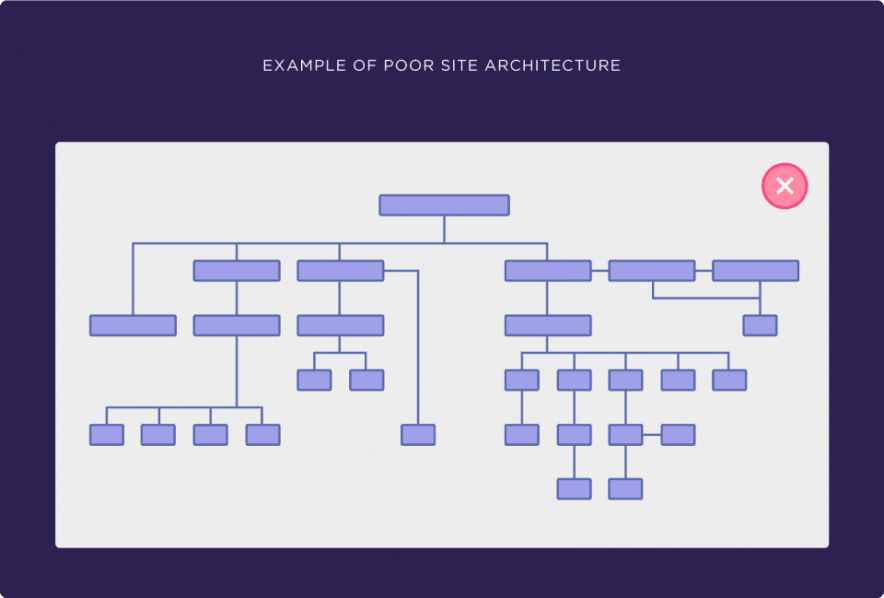 Source: backlinko.com
Source: backlinko.comInstead of this sprawled-out and inconsistent site structure, you should try to create a relatively flat website that’s easy to scale and maintain. Below, you can see how products link back to subcategories that in turn go up to categories—and everything meets at the homepage.
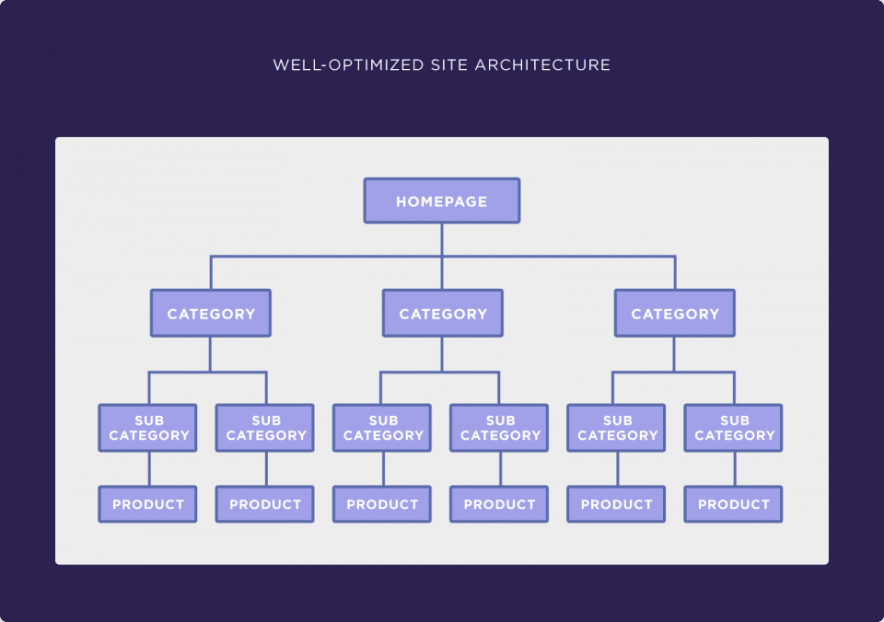 Source: backlinko.com
Source: backlinko.comDo you have to optimize URLs?
Clear and concise URLs also contribute to UX and SEO-friendliness.
Instead of a set of meaningless symbols topped with random numbers, you should try to use shorter and relevant words, and include your keywords within the URL—it’s easy to read for both users and crawlers, which is what you are trying to achieve here.
Just look at these two examples – which one is harder to read?
❌ www.xxyyzz.com/b24/h-1gouiyj-52708405443/32red-dress
✅ www.xxyyzz.com/dresses/red-open-back
2. Run eCommerce-Minded Keyword Research
Any effective SEO strategy starts with smart keyword research. After all, keywords are what bring you the initial visibility and interaction with the potential customer.
Done right, keyword research can help you find the right consumer—this brings more targeted and converting traffic—and show Google that you are a great candidate that matches users’ search intent so you deserve the top rankings.
I could give you a more general round-up on how to do keyword research, but the process is a bit different when it comes to eCommerce sites.
Here’s what your workflow should look like.
Match your products with your initial keyword list
For an eCommerce business, it’s products that define your preliminary keyword portfolio. So the very first step is to list all your category and product pages. Then, select and map—page-by-page—your initial keywords list.
Keywords that focus on your product
Product-focused search terms are the backbone of an eCommerce keyword strategy. So you should always prioritize them.
But don’t forget about your home page, category pages, and blog articles. Each of these pages has to feature a clear selection of keywords that are:
- Relevant to your business and product portfolio
- Medium-to-high search volume (a metric that reflects how popular the keyword is and how often it appears across people’s searches)
- Feasible to rank for (typically comes in a metric called keyword difficulty that measures how competitive the keyword is)
Keywords that match buyer intent
Google places a growing emphasis on user intent, and so should you.
Keywords generally fall under four broad categories:
 Source: Semrush blog
Source: Semrush blogAs an e-tailer, you should focus more on transactional keywords, because your main end goal is to attract people who are in the ‘ready to buy’ mode—and transactional keywords are exactly what reflects when a user is at the very last stage of the purchasing funnel.
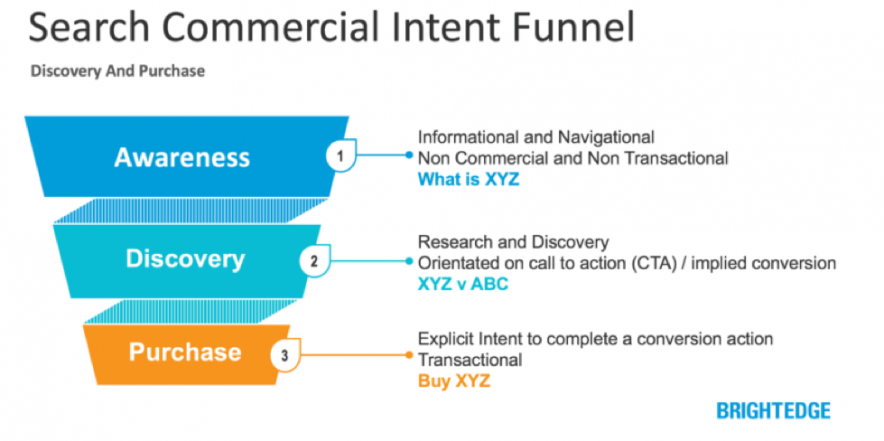 Source:
Source: For instance, when a user Googles “women’s dress”, this is a somewhat broad keyword (otherwise called ‘head’ term) that typically corresponds to the top of the buying funnel (awareness or research stage). This implies that a user looking up this query is likely not yet ready to buy and is simply considering their options.
Now, if that keyword turns into “red women’s Valentino dress with an open back, size S”, it’s a clear indicator that the person is ready to buy and wants a very specific product. This is what a long-tail keyword is—it often reflects commercial or transactional intent. And it’s something you should work hard on capturing with your eCommerce keyword strategy.
Find the most promising long-tails
Now, it may seem pretty intuitive to simply add a few adjectives and product specs to your head term, and voila, there you have your list of long-tail keywords.
It doesn’t work like that, though.
Keyword research is a data-driven process so you should get hold of various keyword metrics that will help to pick the most relevant search terms that can bring the biggest impact.
This is where you need to turn to external tools.
My latest post already revealed why I find Semrush to be the most efficient tool for keyword research. But the platform is especially valuable for eCommerce sites as it’s the only solution that features the “keyword intent” metric.
So in this article, I will simply show how I’d use Semrush to find those long-tails. Even if you don’t choose this as your go-to keyword solution, you can still use the same algorithm but add up more manual work for including intent into the mix.
Find the most profitable keywords around your ‘head’ terms
As I mentioned, you shouldn’t just target the broader keywords that typically don’t come with the immediate purchasing intent. Your job is to find related keywords that can bring the most value.
Simply enter the keywords you have from your product/category page inventory, and add them one by one into the Keyword Magic Tool.
This is the perfect tool for building up your long-tail keyword portfolio. Just check out all the related keywords around your head term and choose the ones that have the lowest possible difficulty level and a more or less high search volume.
 Source: Keyword Magic Tool
Source: Keyword Magic ToolInitially, you won’t be targeting keywords with the larger number of monthly searches—they are more general and way more competitive—but with time as you build your site authority in the eyes of Google, you will be able to rank for those keywords as well.
This is how you can come one step closer to dominating the SERPs and even competing against larger eCommerce giants.
Pinpoint keyword intent to focus on transactional queries
All Semrush’s keyword tools feature the “keyword intent” metric but you can also use your common sense.
Yet if you’re using the Keyword Magic Tool, for instance, you can simply filter your list of long-tails by intent and only focus on search terms that imply close conversion to purchase.

In just two steps, we’ve already discovered one potentially worthy long-tail for our “women’s dress” example—”red and white wedding dresses david’s bridal” keyword has the right intent, a sound keyword difficulty, and a solid search volume.
Get keyword ideas from the competition
While your products will always be the key source for your initial keyword ideas, you can also reveal a search term or two from competitors’ keyword portfolios.

Just add your keyword (typically, your product) into the Amazon search bar, and its Suggest feature will show some of the most popular phrases/searches around your keyword.
Explore competitors’ existing keyword portfolio (and stats)
Now, if you have some specific competitors—and there’s a 99.99% chance that you do—you can take a sneak peek into their keyword profiles and see which terms bring them the majority of traffic.
For this, you’ll again need to turn to external help—a tool like Organic Research.
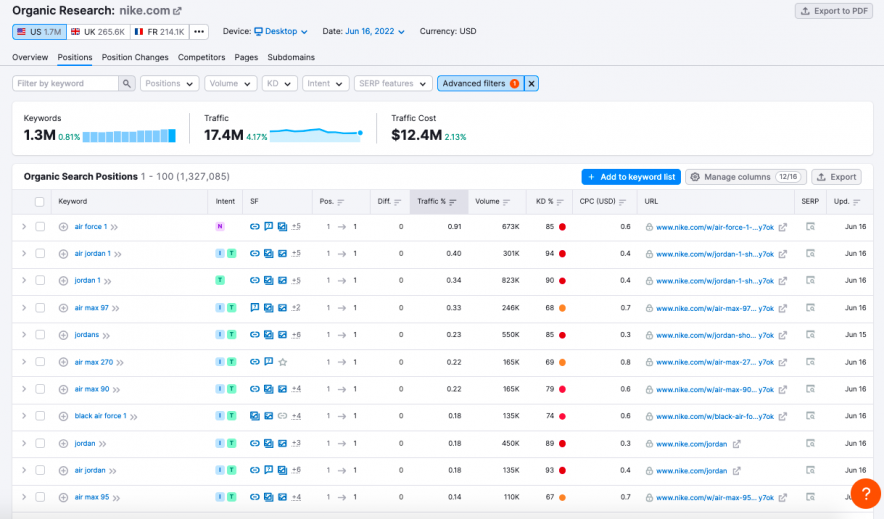 Source: Semrush Organic Research tool
Source: Semrush Organic Research toolYou just simply enter your competitor’s website into the tool and it reveals their keyword portfolio, showing which keywords bring them the largest share of traffic along with positions they rank in for each of these keywords.
Pinpoint missing keyword opportunities
There’s another thing you can do to unwrap some keyword ideas you might not have considered through your research and analysis.
Gap analysis—stacking up competitors’ keyword profiles up against you and/or each other—can also bring some unexpected insights.
For instance, the Keyword Gap tool shows that Nike could be missing over 2,000 keyword opportunities as its rivals all rank for these search terms while the former brand doesn’t.
 Source: Semrush Keyword Gap tool
Source: Semrush Keyword Gap toolIf you narrow this list down by intent (transactional), search volumes (1000+ monthly searches), and keyword difficulty (lower than 59%), you’ll see that the number of ideas does shrink but Nike is still missing out on at least 80 highly-valuable keywords.

Combining all these techniques, you’ll not only gather a list of promising keywords that match your product pages and categories, but also take into account your competitive landscape and difficulty factors.
What’s next? You have to optimize your pages for them.
3. Optimize Your Pages (On-Page SEO)
Here are a few solid SEO best practices for ecommerce sites.
Title tags optimization
Title tags, or simply page titles, play a big role in your SEO optimization as they affect click-through, clarifying to people and the search engines what the page is all about.

The best practices for title tag optimization include:
- Keeping your title under a 60-character limit
- Adding your target keywords
- Including your brand name at the very end (see examples above)
Meta descriptions optimization
Meta descriptions refer to the text that shows up right under the title tag in the search results, which means that they also impact your CTR.
To optimize them, you have to:
- Keep your word limit under 150 characters
- Include your keywords (you can be free here to include your related keywords)
- Make sure they are unique to each page (otherwise, you risk having duplicate content which is a big no for SEO)
- Make them accurate and relevant to the actual page content
- Have some enticing elements that show your store’s unique features—free delivery, discounts, special deals, and so on.
Optimize your CTAs
CTAs or “Calls to Action”, are important to any site. But when it comes to eCommerce, you want to make sure your visitors take further action and hit that “buy now” button.
But…it might not be just about “buy now”.
Calls to action range and you should make sure they actually translate to an added benefit to your potential customers.
Tip: You should take a look at rivals’ CTAs and the wording they use across the competing pages. If you spot that a few competitors employ certain phrases that you don’t, it might be a good idea to adopt this language as chances are, you’ve simply missed an important value point.
For instance, the On-Page SEO Checker tool reflects that Amazon’s Texas Instruments engineering calculator’s product page doesn’t have one phrase its other competitors employ, so it could be beneficial to also add the “online calculator” phrase to the page (if relevant, of course).

Image optimization
Keyword optimization isn’t just about the page copy, though.
Your images should also be finetuned to meet the following criteria:
- Make sure each image comes with alt-texts—code lines that tell the crawlers what the image is all about. Your alt-texts should also include relevant keywords—you don’t have to create a super compelling copy for those, but make sure not to fall into the trap of keyword stuffing. This helps to rank for image search and show up in image results.
- Make proper image filenames—this also affects the way search engines see your images and helps to read them.
- Reduce your file sizes and compress your images, trying to keep them down to 1-2MB. Excessive file size can hinder your page speed, which is a ranking factor, and you don’t want to lose ranks just because your images were too large. Read more about image optimization from here.
Example of proper file name:
❌ IMG758475red.png
✅ red-dress-valentino-open-back.png
Make Sure Each Page Comes With Unique Content
The biggest trap for most eCommerce sites is that they feature too many products. It’s typically a good thing for each page to feature unique content and descriptions, and that’s time-consuming to implement.
But you have to take the time and optimize each and every page for its unique keyword. After all, it’s content that search engines rank so you want to do better than your rivals who might think it’s okay to have similar descriptions that almost all blur into one.
Here’s how not to get lost:
- Laser-focus your efforts—don’t work on everything at once. Instead, prioritize the most important pages.
- While you don’t need walls of text, make sure to add at least 250-500-word descriptions to both product and category pages. It can do wonders as many eCommerce sites really forgo this step.
- Once again, don’t forget about your keywords!
Don’t forget about Schema Markup
Just as with titles, Schema markup helps users and search engines better understand what the page is about and anticipate what they can see there.
 Source: Business2community
Source: Business2communitySearch Engine Land finds that some sites see a 30% spike in CTR—all thanks to various types of schema features:
- Reviews and ratings
- Breadcrumbs
- Business/contact details
- Product schema
- Product availability
- FAQs
Build internal links
Remember when I mentioned that no page should be more than 4 clicks away from the main page?
That’s what internal links are here for.
First off, great internal linking helps crawlers find your pages and index them. And the more links coming to a page, the more important it looks to them.
Plus, users might never find your page if it’s hidden behind 5+ other pages so you will simply not get the traffic you need for that product. Both visitors and crawlers will simply ignore it.
You can identify these pages within your Google Search Console or use a more holistic site-auditor like the Site Audit tool to identify various site issues for you and even offer improvement recommendations.

4. Get Rid of All Technical SEO Issues
If you’re wondering how to do SEO for ecommerce websites, start with site audits.
eCommerce sites typically feature hundreds if not thousands of pages. And it’s hard to detect, control, and resolve each and every problem manually.
While an issue may have an easy fix, often the hardest part is to find it. The consequences, however, can be grim as your lack of internal links or the presence of duplicate content can be the thin line between you and your better-ranking competitor.
Semrush’s Site Audit tool is really powerful, checking your site against 150+ site health checks that range from indexing, mobile, and international SEO, to site speed, site security, and structured data issues.

The list of all the things that can go wrong with your site is endless, but not all issues are created equal. Therefore, I will just focus on the most important site health problems you should pay special attention to.
Duplicate content
Duplicate content is one of the most widespread SEO issues across eCommerce sites. You have too many products that are often similar so it’s hard to come up with an original description for the hundredth red dress.
But it can result in crawl waste, meaning that Google will simply ignore all the pages that they deem to be duplicate content.
You should avoid duplicates at all costs if possible, but if you absolutely have to use the same copy for another page, make sure to:
- Add canonical tags to let crawlers know which product page to index.
- Mix duplicate with original text and make sure the former doesn’t exceed a certain % of the space.
Thin Content
Another common copy-related issue is thin content.
You may have invested in the original text, but if you have a low text to HTML ratio, Google may flag the page as the one with thin content.
There’s a quick fix here. Simply add a bit more content, making sure it reaches at least a 500-word limit.
Deep or orphaned pages
This we covered a lot already. Great internal linking should help you avoid the issue of deep (more than 3 clicks away) or orphaned (no internal links whatsoever) pages.
A flat site structure and a great auditor that pinpoints any issues with internal links will help to resolve these issues once and for all.
Slow page speed
As Google puts growing emphasis on mobile experiences, page load speed has become one of the most important factors that affect both your rankings and user experience.
If you see your page loading too slowly, try to do the following:
- Compress your images (TinyPNG is a great site that can help)
- Employ a CDN—it can both accelerate your site speed and bring an extra layer of security to your site.
Missing or broken canonical links
Once again, when you have hundreds of pages, it’s hard to keep track of all the ones that go missing or broken. This can impact your crawlability and affect your efficiency.
The Site Audit tool will immediately let you know (as will Google Search Console).
Keyword cannibalization
It’s often the case that eCommerce sites have a few pages ranking for the same keyword which leads to having the wrong page being indexed and ranked higher.
Instead of your product page, Google might bring up your blog post that you didn’t mean to rank that high.
So whenever you spot something like that, make sure you have a clearer keyword strategy for each of your pages. If you can’t yet get to optimizing your pages for unique keywords, you can use this temporary workaround—pick the one you want to be ranked and simply use rel=”noindex” tags or canonicalization.
Read: Keyword Cannibalization: What Is It And How to Fix It to Improve Your Website’s SEO
Site security issues
Any eCommerce website has to be HTTPS. This allows you to provide reliability and trustworthiness, especially when you accept online payments.
If you had an HTTP site before, though, you might see migration issues or simply miss an expiring HTTPS certificate.
Keep a close eye on both aspects of your site security as Google considers security (namely HTTPS) to be a lightweight ranking factor.
5. Ensure a Strong Backlink Portfolio
As much as internal links are an important aspect of eCommerce SEO, external links play a comparable role.
The more sites link back to your online store, the more authoritative you look in the eyes of the crawlers. Plus, there’s the added benefit of expanding your reach and visibility to other audiences.
While link-building is an art and science of its own, I’ll unwrap the top three quickest and most efficient techniques that will most surely help to expand your backlink portfolio.
Give your existing broken links a fix
If you’re on the market even for a short time, chances are you already have some kind of backlink profile to work with.
The quickest way to grow the number of external links bringing traffic to your site is to fix what’s broken.
Give your backlink profile a thorough review with a tool like a Backlink Audit Tool, find broken links coming from high-authority sites, and reach out to them asking for a fix.
Find link-building ideas from the competition
Just as with most things in eCommerce, there’s no need to reinvent the wheel and come up with brand new strategies each time you roll up your sleeves trying to build some links.
Your competitors have probably done a part of the job for you.
Use the very same concept of gap analysis we mentioned before, only for backlinks now.
The Backlink Gap tool will stack your backlink profile up against up to five competitors and show sites that link back to them but not to you. And this is the sweet spot that likely contains a certain number of potential link-building partners you can easily reach out to and get a backlink from.
 Source: Backlink Gap tool
Source: Backlink Gap toolAsk your suppliers and distributors for links
You don’t always have to go so far searching for link-building partners, though. You can simply ask your suppliers and distributors to add you to their pages.
For instance, if you are a reseller, ask the original seller to add you to their partner or “where to buy this product” pages.
This is probably one of the most reliable and easy ways to build authoritative backlinks.
6. Unleash the Full Power of Local SEO
Some eCommerce sites—namely the ones that have an offline presence—can also leverage the power of local SEO. It’s often easier to get visibility in local search where you naturally have fewer competitors than in a race against the entire worldwide competitive landscape.
Local SEO implies that you are targeting consumers who are searching for location-specific terms. Anything ”…near me”, “the closest…”, “…in San Francisco” query will be a local search.
If this is the kind of consumer that’s relevant to your business, you can try a few easy tricks to put your business on their radar.
Create a Google Business Profile
Having a Google Business Profile can give you an impressive visibility opportunity as you will show up in local search results.
Simply claim your business and make sure to fill out as much business information as possible—from product info and business features to reservations and pricing; it’s best to mention it all.
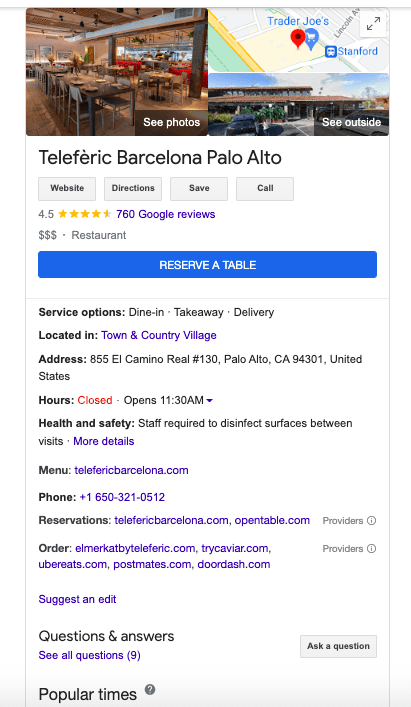
Show up in local directories
When it comes to local rankings, Google gives preference to businesses that are prominent in the given locale. This means that your company should show up in all local directories that have your company name and address.
From more global directories like Yelp and Foursquare to some niche and location-specific business listings, make sure your business is everywhere.
Pro tip: You can use a tool like Local Listing Management to automatically distribute and manage your business listings across various local directories, and even get your business optimized for voice search.
This is the easiest way to successfully manage your local visibility as with local listings, you have to ensure consistency of your business data and keep watch on your local rankings.
Final Thoughts | Best SEO Strategy for eCommerce Websites
SEO takes time and patience. This is especially true for eCommerce businesses as they operate in one of the most competitive market segments.
But the benefits you’ll reap are worth every minute of your time. And unlike advertising, social media, and many other marketing channels, SEO is set for long-term sustainable success. And what’s best is that it doesn’t simply help to attract visitors, it also helps to finetune UX and your content, impacting your click-through and conversions.
So make sure to take time and invest in SEO activities for eCommerce websites because this is one of the few ways to achieve incremental growth.
And as you will need external help and tools that will help you along your optimization journey, this unique 30-day Semrush Guru trial will come in handy and help you build a bulletproof SEO strategy that will bring lasting results.

Keep reading the article at BloggersPassion: Learn Blogging & SEO from Anil Agarwal. The article was originally written by Anil Agarwal on 2022-06-30 05:03:48.
The article was hand-picked and curated for you by the Editorial Team of WP Archives.

